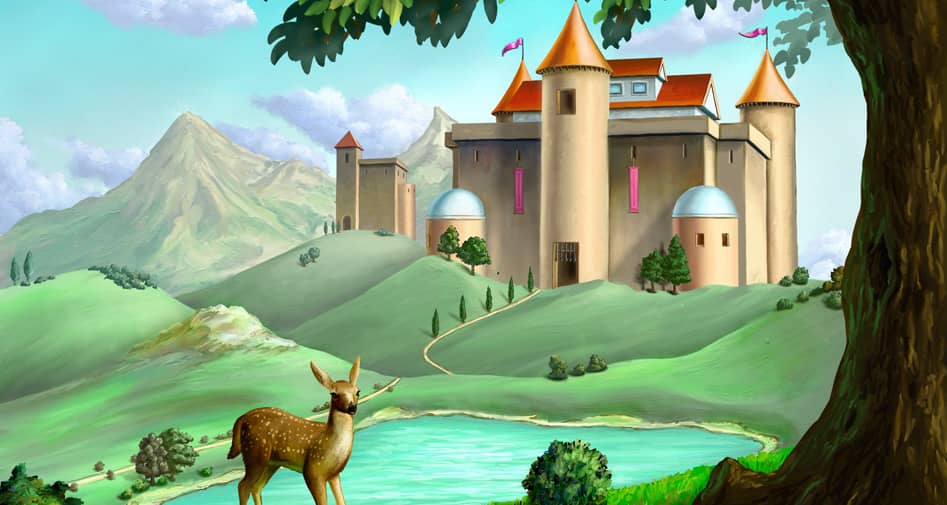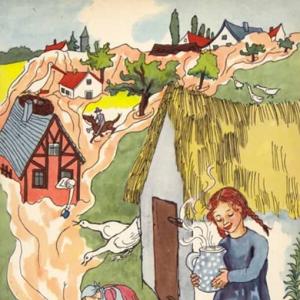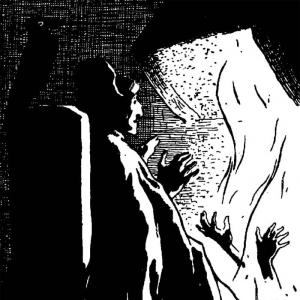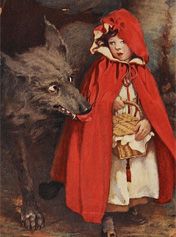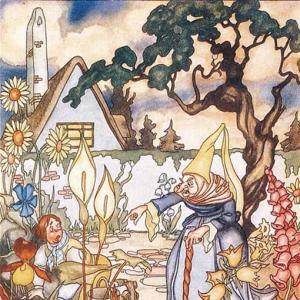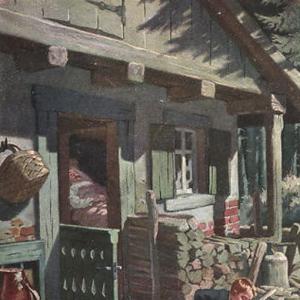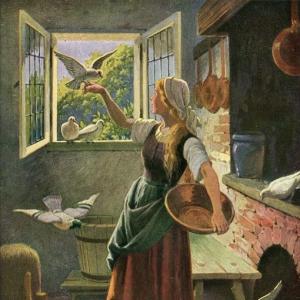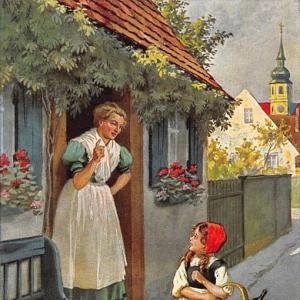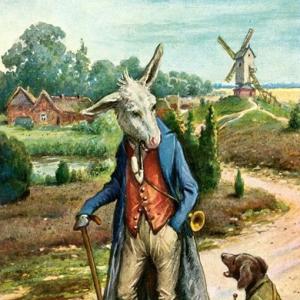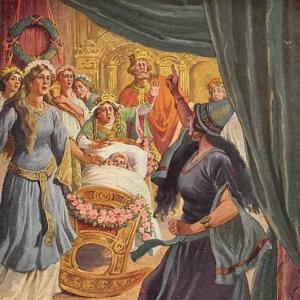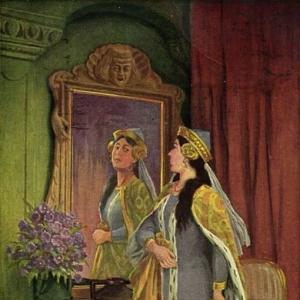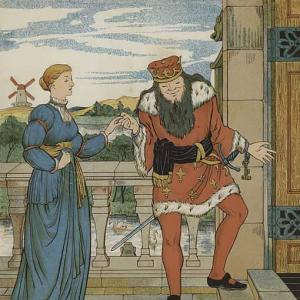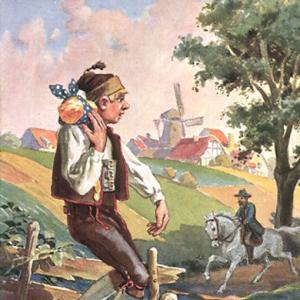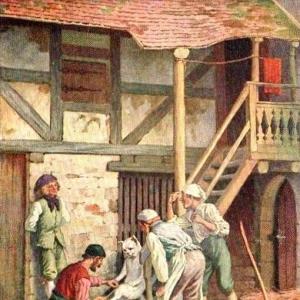Reading time for children: 4 min
A countryman was once going out to plough with a pair of oxen. When he got to the field, both the animals‘ horns began to grow, and went on growing, and when he wanted to go home they were so big that the oxen could not get through the gateway for them. By good luck a butcher came by just then, and he delivered them over to him, and made the bargain in this way, that he should take the butcher a measure of turnip-seed, and then the butcher was to count him out a Brabant thaler for every seed. I call that well sold! The peasant now went home, and carried the measure of turnip-seed to him on his back. On the way, however, he lost one seed out of the bag. The butcher paid him justly as agreed on, and if the peasant had not lost the seed, he would have had one thaler the more. In the meantime, when he went on his way back, the seed had grown into a tree which reached up to the sky. Then thought the peasant, „As thou hast the chance, thou must just see what the angels are doing up there above, and for once have them before thine eyes.“ So he climbed up, and saw that the angels above were threshing oats, and he looked on. While he was thus watching them, he observed that the tree on which he was standing, was beginning to totter. He peeped down, and saw that someone was just going to cut it down. „If I were to fall down from hence it would be a bad thing,“ thought he, and in his necessity he did not know how to save himself better than by taking the chaff of the oats which lay there in heaps, and twisting a rope of it. He likewise snatched a hoe and a flail which were lying about in heaven, and let himself down by the rope. But he came down on the earth exactly in the middle of a deep, deep hole. So it was a real piece of luck that he had brought the hoe, for he hoed himself a flight of steps with it, and mounted up, and took the flail with him as a token of his truth, so that no one could have any doubt of his story.
 Learn languages. Double-tap on a word.Learn languages in context with Childstories.org and Deepl.com.
Learn languages. Double-tap on a word.Learn languages in context with Childstories.org and Deepl.com.Backgrounds
Interpretations
Adaptions
Summary
Linguistics
„The Flail from Heaven“ is a lesser-known fairy tale collected by the Brothers Grimm, who were German academics, linguists, and cultural researchers. The story is part of their famous collection „Kinder- und Hausmärchen“ (Children’s and Household Tales) first published in 1812. The collection, which has been revised and expanded over the years, includes popular stories such as „Cinderella,“ „Snow White,“ and „Hansel and Gretel.“
Jacob and Wilhelm Grimm were among the first to systematically collect and preserve traditional folktales as part of a broader scholarly movement known as Romantic Nationalism. This movement was motivated by an interest in preserving the cultural heritage and folklore of various nations, which was seen as a vital part of a nation’s identity.
The Brothers Grimm collected their tales from various sources, including friends, acquaintances, and published works. They aimed to preserve the stories as authentically as possible, although they did make some edits and adaptations to make the tales more accessible and suitable for a wider audience, especially for children.
While „The Flail from Heaven“ is not as widely recognized as some of the other Grimm fairy tales, it still contains many elements typical of their stories, such as fantastical events, moral lessons, and the presence of supernatural beings. Like many other Grimm tales, „The Flail from Heaven“ reflects the culture and values of the time in which it was collected, as well as providing an opportunity for readers to explore and interpret the story in various ways.
„The Flail from Heaven“ can be interpreted in various ways, as is the case with most fairy tales. Here are a few possible interpretations:
Resourcefulness and quick thinking: The countryman’s ability to adapt to unexpected situations, such as striking a deal with the butcher or creating a rope from chaff, illustrates the importance of resourcefulness and quick thinking in overcoming challenges.
Curiosity and exploration: The countryman’s decision to climb the tree to observe the angels demonstrates a spirit of curiosity and exploration. This aspect of the story can be seen as an encouragement to seek out new experiences and learn from them.
The consequences of greed: The butcher’s agreement to pay the countryman an excessive amount for the turnip seeds may suggest that he is driven by greed. This interpretation is supported by the lost seed growing into a massive tree, which ultimately leads the countryman to a dangerous situation.
The power of storytelling: The countryman’s tale of his journey to heaven and his encounter with the angels is so incredible that he feels the need to keep the flail as evidence. This highlights the power of storytelling and how sharing experiences can have a significant impact on others.
The balance of luck and hard work: While the countryman encounters moments of good fortune, such as finding the butcher and stumbling upon the massive tree, he also relies on his own skills and resourcefulness to navigate through his journey. This could be interpreted as a message about the importance of balancing luck and hard work in life.
„The Flail from Heaven“ is not one of the most well-known fairy tales from Brothers Grimm, and as a result, it has not been adapted as frequently as some of their more popular stories. However, there have been a few adaptations of the tale in various media, including:
„The Heavenly Flail“ (1979): This West German film adaptation of the story is a live-action film directed by Herbert Achternbusch. It tells the story of a peasant who receives a magical flail from an angel, which he uses to become wealthy and powerful, but soon realizes the error of his ways.
„The Magic Flail“ (1983): This episode of the animated TV series „Faerie Tale Theater“ is an adaptation of „The Flail from Heaven.“ It stars Matthew Broderick as the peasant who receives the magical flail and Beverly D’Angelo as his wife. The episode features a humorous twist on the story, with the peasant using the flail to win a bet with the devil.
„The Flail from Heaven“ (2012): This short animated film by Russian animator Anton Dyakov is a faithful adaptation of the Grimm Brothers‘ story. The film uses hand-drawn animation and a simple, muted color palette to create a dreamlike atmosphere.
„The Magic Flail“ (2020): This episode of the podcast „Fabled“ is a retelling of „The Flail from Heaven“ set in the American West. It features a farmer who receives a magical flail from a mysterious stranger and uses it to strike it rich, only to suffer the consequences of his greed.
Overall, „The Flail from Heaven“ has not been adapted as frequently as some other Grimm Brothers‘ stories, but it has still inspired a few adaptations in various media.
„The Flail from Heaven“ is a Brothers Grimm fairy tale about a countryman who experiences an extraordinary adventure. One day, he takes his oxen to plow his field, but their horns begin to grow uncontrollably, preventing them from returning home. A butcher happens to pass by, and they strike a deal: the countryman will trade his oxen for a measure of turnip seed, receiving a Brabant thaler for each seed.
On his way to deliver the turnip seed, the countryman accidentally loses one seed. Nevertheless, the butcher pays him as agreed, and the countryman sets off for home. As he walks back, he notices that the lost seed has grown into a massive tree reaching up to the sky. Curious about what the angels are doing in heaven, he decides to climb the tree.
Upon reaching the top, he sees the angels threshing oats. As he watches them, he suddenly notices the tree beginning to wobble, as someone is cutting it down below. Fearing a dangerous fall, he quickly gathers chaff from the oats, twists it into a rope, and snatches a hoe and a flail from heaven. He uses the rope to lower himself to the ground, landing in a deep hole.
Thanks to the hoe, the countryman is able to dig a flight of steps and climb out of the hole. He keeps the flail as a token of his incredible journey, ensuring that no one can doubt his extraordinary tale.
The fairy tale „The Flail from Heaven“ from the Brothers Grimm demonstrates several notable elements of linguistic and thematic interest that are characteristic of traditional fairy tales.
Structure and Style
Simple Language: The narrative employs simple and straightforward language, reflecting its roots in oral tradition and its intended accessibility to both children and adults. The syntax is uncomplicated, with a sequential narrative structure that is easy to follow.
Repetitive and Formulaic: The story utilizes repetition and formulaic expressions, such as the incremental growth of the oxen’s horns and the step-by-step description of the peasant’s journey. This repetition aids memory and engagement.
Themes and Motifs
Transformation and Growth: Central to the tale is the theme of transformation, symbolized by the extraordinary growth of the oxen’s horns and the magically growing seed. This motif aligns with the common fairy tale theme of unexpected change leading to new opportunities.
Cleverness and Ingenuity: The peasant demonstrates cleverness through his negotiations with the butcher, and his resourcefulness is highlighted when he manages to descend safely from „heaven“ by twisting a rope of chaff and using a hoe. Such traits are often celebrated in fairy tales, where protagonists succeed through wit rather than brute strength.
Heavenly Curiosity and Divine Interaction: The narrative explores the theme of curiosity about the divine or otherworldly, as seen when the peasant climbs the tree to see what the angels are doing. This reflects humanity’s age-old fascination with the heavens and what lies beyond the human world.
Symbolism
Oxen and Agriculture: The oxen, as traditional symbols of labor and agriculture, reflect the peasant’s connection to the land and his livelihood. Their transformation suggests a disruption in the ordinary, prompting a series of fantastical events.
The Tree and Skyward Ascent: The seed growing into a sky-reaching tree is reminiscent of the archetypal “world tree” or “axis mundi,” a symbol of connection between earth and heaven.
Heavenly Tools and Truth: The flail and hoe, tools of labor even found in heaven, symbolize the convergence of the mundane and the divine. Bringing the flail back as evidence reinforces the importance of tangible proof and truth in human affairs.
Moral and Interpretation: The tale subtly conveys moral lessons about resourcefulness, the virtues of seizing opportunities, and the importance of evidence (bringing back the flail to validate his experience). The peasant’s adventure rewards his cleverness and serves as a cautionary tale about the consequences of losing even a single seed.
Overall, „The Flail from Heaven“ blends the speculative with the practical, merging fantasy with elements of everyday life, a hallmark of Grimm Brothers‘ storytelling. Through its linguistic simplicity and rich symbolism, the story continues to captivate the imagination and convey timeless lessons.
Information for scientific analysis
Fairy tale statistics | Value |
|---|---|
| Number | KHM 112 |
| Aarne-Thompson-Uther-Index | ATU Typ 1960A |
| Translations | DE, EN, DA, ES, PT, IT, JA, NL, PL, RU, TR, VI, ZH |
| Readability Index by Björnsson | 34.9 |
| Flesch-Reading-Ease Index | 81.3 |
| Flesch–Kincaid Grade-Level | 8.1 |
| Gunning Fog Index | 11.1 |
| Coleman–Liau Index | 6.3 |
| SMOG Index | 8 |
| Automated Readability Index | 8.7 |
| Character Count | 1.951 |
| Letter Count | 1.496 |
| Sentence Count | 16 |
| Word Count | 398 |
| Average Words per Sentence | 24,88 |
| Words with more than 6 letters | 40 |
| Percentage of long words | 10.1% |
| Number of Syllables | 472 |
| Average Syllables per Word | 1,19 |
| Words with three Syllables | 11 |
| Percentage Words with three Syllables | 2.8% |
